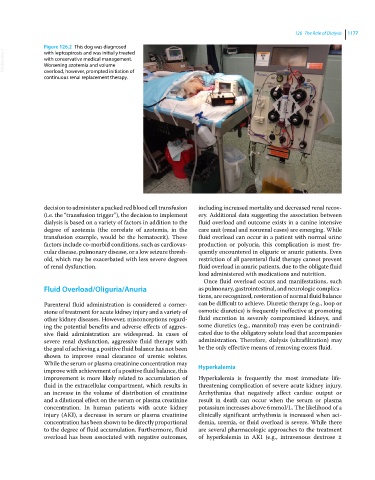Page 1239 - Clinical Small Animal Internal Medicine
P. 1239
126 The Role of Dialysis 1177
Figure 126.2 This dog was diagnosed
VetBooks.ir with conservative medical management.
with leptospirosis and was initially treated
Worsening azotemia and volume
overload, however, prompted initiation of
continuous renal replacement therapy.
decision to administer a packed red blood cell transfusion including increased mortality and decreased renal recov-
(i.e. the “transfusion trigger”), the decision to implement ery. Additional data suggesting the association between
dialysis is based on a variety of factors in addition to the fluid overload and outcome exists in a canine intensive
degree of azotemia (the correlate of azotemia, in the care unit (renal and nonrenal cases) are emerging. While
transfusion example, would be the hematocrit). These fluid overload can occur in a patient with normal urine
factors include co‐morbid conditions, such as cardiovas- production or polyuria, this complication is most fre-
cular disease, pulmonary disease, or a low seizure thresh- quently encountered in oliguric or anuric patients. Even
old, which may be exacerbated with less severe degrees restriction of all parenteral fluid therapy cannot prevent
of renal dysfunction. fluid overload in anuric patients, due to the obligate fluid
load administered with medications and nutrition.
Once fluid overload occurs and manifestations, such
Fluid Overload/Oliguria/Anuria as pulmonary, gastrointestinal, and neurologic complica-
tions, are recognized, restoration of normal fluid balance
Parenteral fluid administration is considered a corner- can be difficult to achieve. Diuretic therapy (e.g., loop or
stone of treatment for acute kidney injury and a variety of osmotic diuretics) is frequently ineffective at promoting
other kidney diseases. However, misconceptions regard- fluid excretion in severely compromised kidneys, and
ing the potential benefits and adverse effects of aggres- some diuretics (e.g., mannitol) may even be contraindi-
sive fluid administration are widespread. In cases of cated due to the obligatory solute load that accompanies
severe renal dysfunction, aggressive fluid therapy with administration. Therefore, dialysis (ultrafiltration) may
the goal of achieving a positive fluid balance has not been be the only effective means of removing excess fluid.
shown to improve renal clearance of uremic solutes.
While the serum or plasma creatinine concentration may Hyperkalemia
improve with achievement of a positive fluid balance, this
improvement is more likely related to accumulation of Hyperkalemia is frequently the most immediate life‐
fluid in the extracellular compartment, which results in threatening complication of severe acute kidney injury.
an increase in the volume of distribution of creatinine Arrhythmias that negatively affect cardiac output or
and a dilutional effect on the serum or plasma creatinine result in death can occur when the serum or plasma
concentration. In human patients with acute kidney potassium increases above 6 mmol/L. The likelihood of a
injury (AKI), a decrease in serum or plasma creatinine clinically significant arrhythmia is increased when aci-
concentration has been shown to be directly proportional demia, uremia, or fluid overload is severe. While there
to the degree of fluid accumulation. Fur thermore, fluid are several pharmacologic approaches to the treatment
overload has been associated with negative outcomes, of hyperkalemia in AKI (e.g., intravenous dextrose ±

